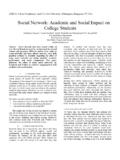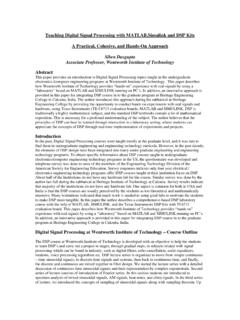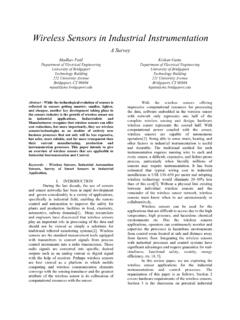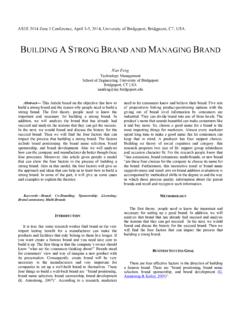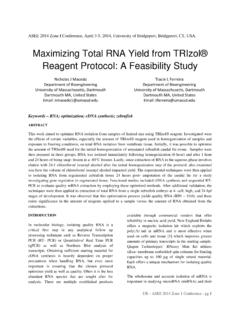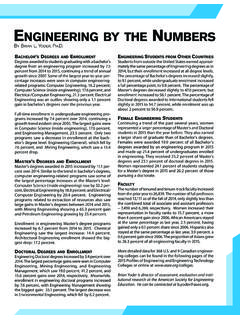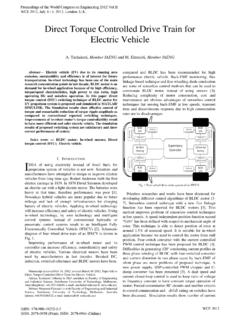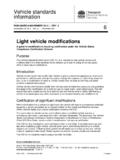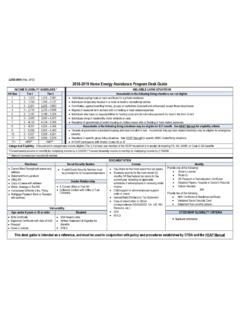Transcription of ELECTRIC MOTORCYCLE ANALYSIS
1 ELECTRIC MOTORCYCLE ANALYSIS . Thy Dinh Bryan Slater West Virginia University Institute of Technology West Virginia University Institute of Technology SPACE Club Chapter of WVU Tech SPACE Club Chapter of WVU Tech Montgomery, USA Montgomery, USA. I. INTRODUCTION IV. RESULTS. In this experiment a team of three mechanical engineers i. Efficiency (Thy Dinh, Bryan Slater, and Branden Frazier) will be performing an ANALYSIS of the 1996 Kawasaki Ninja 250R that After researching the gas engine on the 1996. has been converted from a gasoline powered bike to an ELECTRIC Kawasaki 250R, the specifications for the engine powered bike. Using the knowledge gained from previous were found in two separate sources (1, 2) .To ensure engineering courses, the team members have sufficient accuracy, the two sources were compared. It was knowledge and skill to complete the experiment. After the found that the sources were in congruence about the completion of the experiment, the results will determine which specifications of the bike.
2 Therefore, the team felt version of the bike is best for the environment and for the confident proceeding to calculate the efficiency of economy. The team will be using the data which was provided the ELECTRIC MOTORCYCLE . The team from the previous by last year's engineering students (Josh May, Bryant Gorrell, year had a goal of attaining 50-60 mph with 20-25. and Andrew Blatt) who have completed the conversion of the miles per charge. They were able to achieve 40 mph Kawasaki Ninja gas bike to ELECTRIC . before the MOTORCYCLE was in the shop again. In using the formula for efficiency in conjunction with II. PREPARE YOUR PAPER BEFORE STYLING the results from last year the ELECTRIC motor efficiency would be calculated (3). This experiment will consist of three main parts. The first part is to restore the MOTORCYCLE to operating condition. In order _ =P_out/P_in to complete this task, the team needs to determine the cause of no output in the lithium-ion batteries.
3 Once this is completed Where is the efficiency, Pout is the output power, the team can advance to the second and main objective; and Pin is the input power. In this case, there was not analyzing the ELECTRIC bike in comparison to gasoline bike. As enough information to obtain a percentage efficiency. the final step, the team will compare and discuss the results in Therefore, the team computed the efficiency in the the second part and compare them to a commercial ELECTRIC form of cost per mile, cost per kWh, mile/kWh, and MOTORCYCLE . A figure of the MOTORCYCLE is included in figure 1. compares the results between all three motorcycles III. USING THE TEMPLATE (Gas, Experimental, and Commercial ELECTRIC MOTORCYCLE ). Ideally, the team would find a way to measure the bike's ii. Gas Engine performance in top speed, miles per charge, and watts to charge the bike. Unfortunately, due to unforeseen The original 1996 Kawasaki GPX 250R had a liquid circumstances, the team will need to rely on the results cooled, parallel twin cylinder, DOHC, four valve per produced from when the MOTORCYCLE was in operating cylinder engine.
4 This engine had a compression ratio condition. Next, the efficiency of the MOTORCYCLE will be analyzed by comparing the output power with the input power. of :1 and was capable of producing 45 hp and After that, the gasoline section will consist of an ANALYSIS of the kg-m of torque. The efficiency of the MOTORCYCLE was cost and environmental impact. Then, the ELECTRIC motor 52 mpg, and with a gallon tank, the MOTORCYCLE ANALYSIS will cover the same points as the gasoline engine. had a range of 250 miles. As far as performance, it was able to reach a top speed of mph and a standing quarter mile in s at mph (1). Currently, the cost per gallon of gasoline is $ Using this cost with the efficiency of the gasoline engine produces a cost of $ During the Where x is the number of miles traveled by the bike. combustion of a single gallon of gasoline 8887 grams Then, on the other hand, the cost for the gasoline bike of CO2 are emitted to the atmosphere.
5 This means if is $ per mile. So, the cost for the gas bike is: the bike was to travel 100 miles it would use gallons of gasoline which would produce 17, C= (x). grams of CO2. This equates to g/mile (4). In order to find out when the cost of the modification iii. ELECTRIC MOTORCYCLE will be equal to the amount saved, effectively "paying for itself", the two equations need to be set The GBS LFMP20AH lithium-ion batteries are rated equal to each other. This results in the total number to have a capacity of 20 Amp hours (5).Using the of miles being equal to 37,207. This means, for the formula: modification to be cost effective, the ELECTRIC bike E= QVN needs to be driven 37,207 miles. If the bike was driven a full charge per day, this would result in a Where E is the energy output, Q is the Amp hours, V little over four years to "pay" for the modification. is the Voltage, and N is the number of batteries, the energy required for one charge was found to be 1024 + Wh(6).
6 X=37207 miles E= 20 Ahr* *4 Batteries (37207 miles)/(25 miles/day *365 days/year)= E= kWh years The current rate for Appalachian Power is In terms of the environmental impact, the comparison cents/kWh (7). This cost in conjunction with the is more direct. The Gasoline engine produces amount of energy used per charge results in roughly g/mile of CO2, while the electricity only produces $ per charge. g/mile of CO2. This means, the gasoline engine produces a little over three times as much * $ Carbon Dioxide compared to the ELECTRIC equivalent. There is no disputing the fact, the ELECTRIC motor has a Since the bike is capable of 25 miles per charge, the lesser impact on the environment. As validation for cost per mile comes out to cents/mile. the team's calculations, a comparison to a commercial ELECTRIC MOTORCYCLE will be made. The comparisons $ miles= cents are available in chart 1. A. Authors and Affiliations The average output of CO2 per kWh is 1) Branden Frazier: Associate student.
7 Approximately , which is equal to B. Figures and Tables g/kWh (8). This means, with the amount of kWh used per charging session, the amount of CO2 emissions per charging session is This used in conjunction with the 25. mile per charge capability results in g/mile of CO 2. * kWh = g/charge ( g/charge)/ (25 miles/charge) = g/mile iv. Comparison Figure 1. 1996 Kawasaki 250R. The cost of the modification of the bike was $2, and the cost per mile to operate the bike is $ So, the equation for the total cost of the ELECTRIC bike is: C = 2, + (x). Comparison Gasoline Experimental Zero S REFERENCES. MOTORCYCLE ELECTRIC Commercial MOTORCYCLE ELECTRIC [1] "Kawasaki GPX250R." Kawasaki GPX250R. , Web. 19 Nov. MOTORCYCLE 2013. < (9) >. Initial Cost 13,000 [2] "EX250 Specification." EX250 Specification. , Web. 19 Nov. ($): 2013. < >. Range 250 25 103 [3] "Electrical Motor Efficiency." Electrical Motor Efficiency. , (Miles): Web.
8 19 Nov. 2013. < >. Cost/Mile [4] Greenhouse Gas Emissions from a Typical Passenger Vehicle. : ($): United States Environmental Protection Agency, PDF. Cost of (Fill- [5] May, Josh, Bryant Gorrell, and Andrew Blatt. ELECTRIC MOTORCYCLE : 2nd Recharge up Tank) Generation. Tech. : , Print. ($): [6] "How to Convert MAh to Wh." How to Convert MAh to Wh. , Charge N/A Web. 19 Nov. 2013. Time (Hr.): mile/kWH mile/kWH [7] Components of the Virginia Residential Bill. Digital Appalachian Power, CO2/Mile( g/Mile): Horsepower: 45Hp 15Hp 54Hp Top Speed: 40 95 [8] "How Much Carbon Dioxide (CO2) Is Produced per Kilowatt-hour When Generating Electricity with Fossil Fuels?" Energy Information Administration, June-July 2013. Web. 18 Nov. 2013. Chart 1. Result Comparison < >. [9] Zero S Specification. Zero S ELECTRIC MOTORCYCLE , Web. 1 Dec. 2013.

